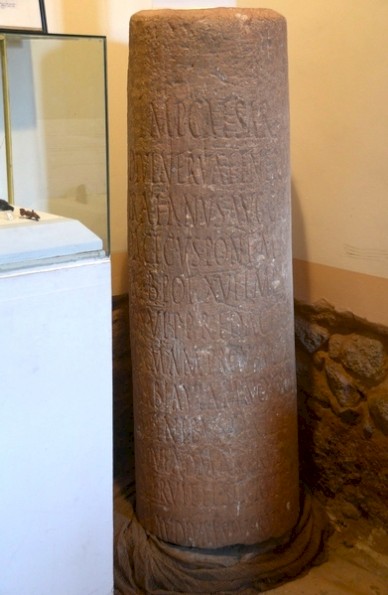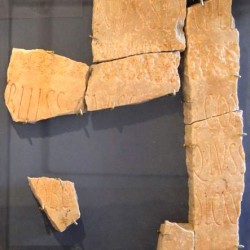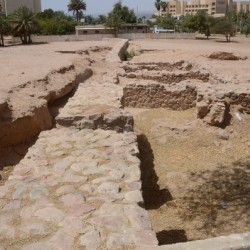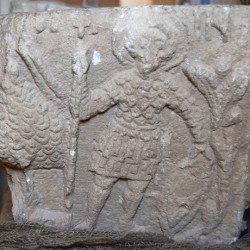Ailana (Akaba)
Q180522Ailana (Greek Αἴλανα): ancient port on the Red Sea, modern Akaba in southern Jordan. There are several related names for this town, all derived from Semitic ayil, "palm tree".
Early History

Ailana is situated at the northern end of the Gulf of Akaba, i.e., the northeastern branch of the Red Sea.note At this place, the Wadi Itr empties itself into the sea. It is also the place where the Araba starts, a long valley, rich in copper, that continues to the Dead Sea. Because there was sweet water and a road from the sea to the north, the area of Aila has always been inhabited.
Archaeological finds at Tall al-Magass and Tall Hujayrat al-Ghuzlan, four kilometers north of Aqaba, go back to the Chalcolithic Period and can be dated to 4200-3600 BCE. A more recent settlement was found at Tall el-Khailifa, which was occupied in the Bronze Age and dominated the entrance to the Araba. In these three villages, people worked copper ores.
The Bible mentions several Iron Age towns in this area: Elath, which must be the same town as Ailana, and Ezion Geber. None of these settlements, which were contested between Judah and Edom,note have been identified so far.
The Nabataean Town
We later find the town in the hands of the Nabataeans. In the first century CE, the city played a role in the incense trade,note and was connected to cities as far away as Charax at the confluence of the rivers Euphrates and Tigris.note No doubt, there were indirect contacts to places in India and perhaps even beyond.
The Peutinger Map shows roads to the west to Egypt, to the north through the Araba to Jerusalem, and to the northeast to Petra. The Periplus of the Red Sea also mentions this road to Petra, plus a small garrison and a customs office that charged one quarter on incoming merchandise.note
The Roman town

The Roman emperor Trajan subdued the Nabataeans in 106 CE and now, Ailana became a Roman city. To develop the area and integrate it better into the Roman world, a road was built from Bosra (south of Damascus) to Philadelphia (modern Amman), Dibon, Kerak, Petra, and – at the southern end of this Via Nova Traiana – Ailana. Writing in the fifteenth century, the Mamluk historian Al-Makrizi mentions that there was an honorific arch just north of the port.
Rome’s commercial interests may have reached as far as Ailana’s interests had always been. Its direct military zone of influence may have extended to the isle of Farasan opposite Yemen, where Latin inscriptions have been found mentioning the emperors Hadrian, Marcus Aurelius, and Lucius Verus.
The city, which may have been garrisoned by subunits of the Third Legion Cyrenaica and the Fourth Martia, certainly served as base of the Tenth Fretensis by the end of the third century.note According to the Notitia Dignitatum, this unit was still in Ailana at the beginning of the fifth century.
Late Antiquity
One of the most spectacular finds from Akaba is a church that can be dated to the final years of the third century. It antedates the great persecution by the emperor Diocletian and the decision by Licinius and Constantine, in 313, to allow the Christian faith (Edict of Milan). This church was partly rebuilt when Ailana received a new city wall, and destroyed by an earthquake in 363. There must have been other places of worship, though.
Bishop Peter of Ailana attended the Council of Nicaea in 325, and later bishops were present during the Council of Chalcedon (451, bishop Beryllus), the Synod of Jerusalem (536, bishop Paul), and the Synod of Constantinople (536, bishop John). During the reign of the emperor Justinian, (527/565), an architect from Ailana built Saint Catherine’s monastery in the Sinai desert.
 Ailana, Building inscription mentioning Constantine the Great |
 Ailana, Roman city wall |
 Ailana, Roman church |
 Ailana, Byzantine capital, showing Saint Theodore |
Two capitals, now in the Archaeological Museum of Akaba, show two saints, Longinus and Theodore. In the Coptic church, these soldier-saints are venerated together on the same day (5 Hator), and it is certainly possible that (some of) the Christians of Ailana accepted the Coptic rites after the Council of Chalcedon in 451.
In 630, bishop John, son or Ruba, acting as governor of Ailana, traveled to Tabuk to conclude a treaty with the prophet Muhamad, in which the Christian and Jewish citizens were protected and the Arab sovereignty was accepted. Ibn Ishaq mentions that the city would pay taxes to the Arabs, which means that the city no longer was part of the Byzantine Empire but had joined the Arab world.note
The Umayyads built a large fort, a rectangle of about 145x170 meters, surrounded by a heavy stone wall. It looks very much like a Roman fort and may very well have been inspired by the fortresses at Bethhorus (modern Lejjun), Adrou (Udruh), and the as yet unidentified fortress of X Fretensis.
 Akaba, Umayyad fort, Wall |
 Akaba, Umayyad fort, Ummayad mosque |
 Akaba, Umayyad fort, Excavation |
 Akaba, Umayyad fort, Postern gate |